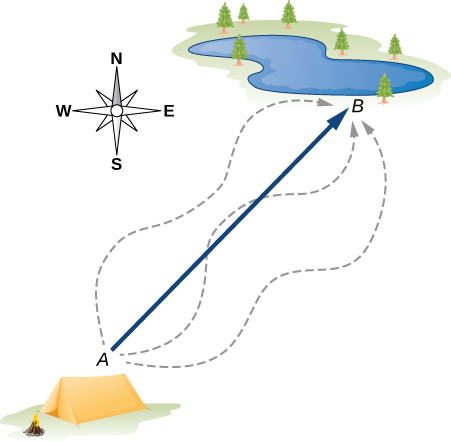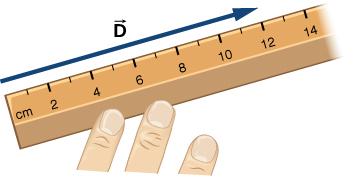| << Chapter < Page | Chapter >> Page > |
Let’s examine vector algebra using a graphical method to be aware of basic terms and to develop a qualitative understanding. In practice, however, when it comes to solving physics problems, we use analytical methods, which we’ll see in the next section. Analytical methods are more simple computationally and more accurate than graphical methods. From now on, to distinguish between a vector and a scalar quantity, we adopt the common convention that a letter in bold type with an arrow above it denotes a vector, and a letter without an arrow denotes a scalar. For example, a distance of 2.0 km, which is a scalar quantity, is denoted by d = 2.0 km, whereas a displacement of 2.0 km in some direction, which is a vector quantity, is denoted by .
Suppose you tell a friend on a camping trip that you have discovered a terrific fishing hole 6 km from your tent. It is unlikely your friend would be able to find the hole easily unless you also communicate the direction in which it can be found with respect to your campsite. You may say, for example, “Walk about 6 km northeast from my tent.” The key concept here is that you have to give not one but two pieces of information—namely, the distance or magnitude (6 km) and the direction (northeast).
Displacement is a general term used to describe a change in position , such as during a trip from the tent to the fishing hole. Displacement is an example of a vector quantity. If you walk from the tent (location A ) to the hole (location B ), as shown in [link] , the vector , representing your displacement , is drawn as the arrow that originates at point A and ends at point B . The arrowhead marks the end of the vector. The direction of the displacement vector is the direction of the arrow. The length of the arrow represents the magnitude D of vector . Here, D = 6 km. Since the magnitude of a vector is its length, which is a positive number, the magnitude is also indicated by placing the absolute value notation around the symbol that denotes the vector; so, we can write equivalently that . To solve a vector problem graphically, we need to draw the vector to scale. For example, if we assume 1 unit of distance (1 km) is represented in the drawing by a line segment of length u = 2 cm, then the total displacement in this example is represented by a vector of length , as shown in [link] . Notice that here, to avoid confusion, we used to denote the magnitude of the actual displacement and d = 12 cm to denote the length of its representation in the drawing.


Suppose your friend walks from the campsite at A to the fishing pond at B and then walks back: from the fishing pond at B to the campsite at A . The magnitude of the displacement vector from A to B is the same as the magnitude of the displacement vector from B to A (it equals 6 km in both cases), so we can write . However, vector is not equal to vector because these two vectors have different directions: . In [link] , vector would be represented by a vector with an origin at point B and an end at point A , indicating vector points to the southwest, which is exactly opposite to the direction of vector . We say that vector is antiparallel to vector and write , where the minus sign indicates the antiparallel direction.

Notification Switch
Would you like to follow the 'University physics volume 1' conversation and receive update notifications?